Can Differences in Intelligence Explain Global Inequality?
Jared Taylor, American Renaissance, June 2007
Richard Lynn and Tatu Vanhanen, IQ and Global Inequality, Washington Summit Publishers, 2006, 400 pp.
Ever since the time of the ancient Greeks — and probably well before — people have wondered why some people are rich and others are poor. For most of human history, they assumed it was because people are not born with the same abilities. In The Republic, Plato wrote that babies come into the world with different inherited natures, and that if the most able men had children with the most able women they would produce an intelligent ruling class. Even Jean-Jacques Rousseau, who planted many of the seeds of liberal foolishness, believed abilities were fixed. Alexis de Tocqueville was impressed by the equality of conditions in America, but thought there could never be complete equality because people are innately unequal: “differences of ability originate from God or from nature.”
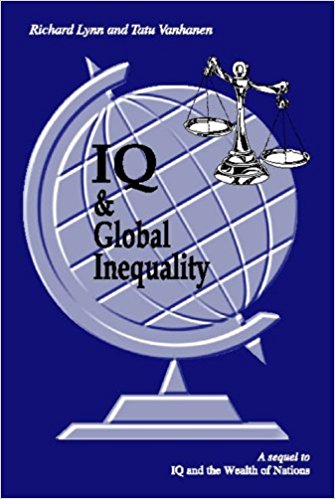
Today, of course, the fashion in the West is to claim that environment counts for everything and that the right “programs” would ensure equality.
IQ and Global Inequality, is a return to common sense. It demonstrates virtually irrefutably that just as differences in intelligence largely explain individual differences in wealth and social status within societies, differences in average intelligence explain national differences in wealth and well-being.
Together, the authors bring great wisdom and scholarship to the question of inequality. Tatu Vanhanen, emeritus professor of political science at the University of Tempere, Finland, has written many books, among them the little-known classic, Ethnic Conflicts Explained by Ethnic Nepotism. Richard Lynn, emeritus professor of psychology at the University of Ulster in Ireland, has written no fewer than four books that have been reviewed in AR — a record. IQ and Global Inequality is an expanded version of IQ and the Wealth of Nations, which the same authors wrote in 2002, but is now out of print.
Conventional Theories
Ever since decolonization in the 1960s, the wealthy white nations have made two key assumptions about poor countries: that bad government policies have made them poor, and that the West must help them get rich. White countries have therefore poured billions of dollars into the tropics and endlessly lectured Third-World dictators on market economies, capital formation, and deregulation. The West has tried debt forgiveness, foreign investment, subsidized education, and birth-control clinics, but many countries are still poor. In 2002, William Easterly wrote in The Elusive Quest for Growth that nothing really works, that “aid will not cause its recipients to increase their investments; they will use aid to buy more consumption goods.” Still, many people persist in believing that if rich countries tried harder, the whole world would be middle class. As the head of the United Nations Development Program said in 1997: “Poverty is no longer inevitable. The world has the material and natural resources, the know-how, and the people to make a poverty-free world a reality in less than a generation.”
Profs. Lynn and Vanhanen argue otherwise. First they note that regional inequality is only a few centuries old. Up until about 1400, virtually everyone everywhere barely got by. Since then, in some countries, whole populations have climbed well beyond the subsistence level, and in the last 200 years a few nations have pulled sharply ahead. The authors also note that some poor countries made good progress in the last 60 years while others went backwards. Before the Second World War, hunger was mostly limited to non-colonized Asia. Now it is mainly a problem in decolonized Africa. In East Asia, the number of people living on less than one dollar a day has dropped sharply, while it has risen in South Asia, Latin America, and Sub-Saharan Africa.
Profs. Lynn and Vanhanen point out why conventional theories about underdevelopment cannot explain these things: “they do not pay any serious attention to human diversity.” Some societies stay poor because their populations are not, on average, intelligent enough to run an efficient economy.
The authors begin their analysis of intelligence with a short history of IQ testing, and explain concisely why IQ has a heritability of approximately 0.88 and is so little subject to environment. Aside from twin studies, some of the most persuasive evidence comes from ordinary families. IQ scores in childhood predict adult socio-economic status better than parental status does. Some 25 percent of children will end up with higher or lower status than their parents, and IQ is the best indicator of which way they will go. Likewise, within the same family, children with the highest IQs tend to be the most successful. IQ, then, is one of the best predictors of virtually every desirable — or undesirable — social outcome. Smart people tend to make more money, get more education, commit fewer crimes, have fewer illegitimate children, stay healthier, and live longer than dim people.
The main argument of this book, as it was with IQ and the Wealth of Nations, is that just as an individual’s intelligence explains a great deal about him, the average intelligence of a nation’s population explains a great deal about it. The central methodology of this book, therefore, is to compare IQ data for different nations to national well-being. The authors have found good testing data for no fewer than 192 countries, and have left out only tiny places like Vatican City, Monaco, San Marino, Lichtenstein, Nauru and Tuvalu.
Clearly, there are better IQ data for some countries than others, but this book probably reflects the most thorough compilation of world-wide intelligence testing reports available anywhere, and includes an extensive listing of the sources. Where possible, Profs. Lynn and Vanhanen have cross-referenced IQ data to international comparisons in such things as mathematics ability; high national IQ scores correlate closely with high academic ability.
There are many measures of national well-being, and the authors have chosen a mix of five such measures against which to plot IQ. The first is per capita gross national income. This is modified to reflect purchasing power parity because the same dollar often buys more in a poor country than in a rich one. The second measure of national well being is adult literacy, and the third is the percentage of the population with post-secondary education. The authors note that above a certain percentage, the number of people in college probably has little impact on the economy. Higher education becomes a consumer good rather than career training — especially in rich countries where large numbers of college-educated women are mothers first and workers second — but the extent to which it is a self-improving luxury is a sign of a nation’s wealth and priorities.
The fourth measure of well-being the authors chose is life expectancy at birth, and the fifth is the level of democratization. Democracy will strike many readers as both hard to measure and of secondary importance in evaluating a nation, but one theory is that representative governments arise when wealth is so widespread that no single group can dominate the others.
Profs. Lynn and Vanhanen have calculated a composite of these five measures, which they call the Index of Quality of Human Conditions. They crosscheck this index and its components against the UN’s Human Development Index, which includes such things as undernourishment and infant mortality. They also mention other measures like the corruption index (Mohammed Suharto is reported to have embezzled as much as $34 billion from Indonesia at a time when its gross domestic per capita income was less than $700 per person), and measures of national happiness.
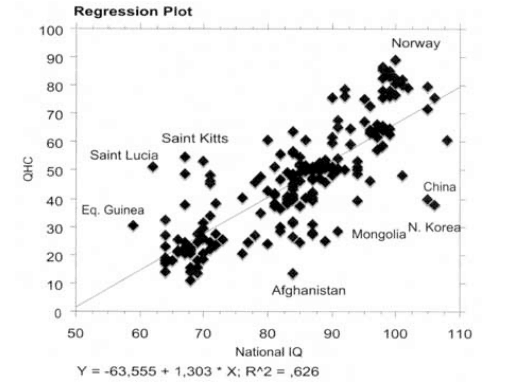
The theory of this book is that IQ has a strong positive correlation with the Index of Quality of Human Conditions (QHC), and of course it does. The chart above plots QHC on a scale of 0 to 100 against IQ for 192 countries. The regression line on the chart shows a very solid correlation, which will surprise only the most militant IQ-atheists. Countries full of smart people are better places to live than countries full of dullards.
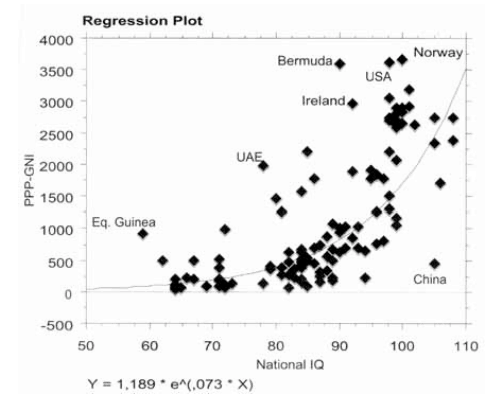
The chart above plots national IQ against national per capita gross income alone. Here, the regression line is a curve, and suggests that an increase in average IQ at the lower levels — from the 60s to the lower 80s, for example — does not produce much economic benefit. It seems that only in societies with an average IQ at least in the mid-80s is there the capacity to build a modern economy that produces real wealth. IQ increases from that point produce very significant gains.
Perhaps the most interesting results, however, are the outliers — the countries that fall well above or below the trend lines. Which countries are more of a success or failure than one would expect from the intelligence of their populations — and why? The table immediately below lists the outliers in both directions. Profs. Lynn and Vanhanen use the term “residuals” to describe either negative or positive distance from the trend line, and have measured that distance in standard deviations.
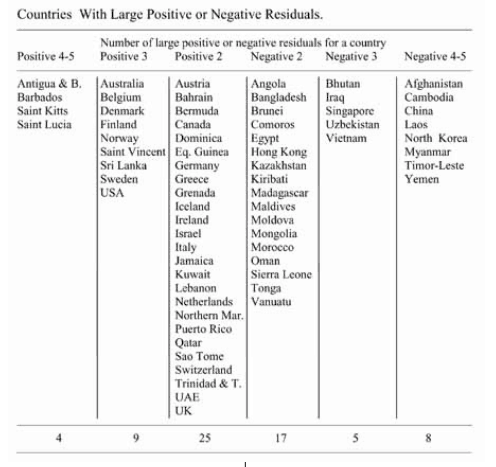
According to this table, which some readers will find the most fascinating in the book, there are four countries with positive residuals of as many as four or five standard deviations (SDs) as calculated by plotting IQ against the five components of the Index of Quality of Human Conditions. This does not mean that Barbados and St. Kitts, for example, outscore Norway and Switzerland in QHC. It means that these four countries are vastly better off — by four or five SDs — than national IQ alone would have predicted. The authors note that they are all island nations and popular tourist destinations. A huge influx of wealthy whites has been a great benefit to these countries.
Otherwise, the 34 countries with positive residuals of two or three SDs are the ones one would expect: advanced Western democracies and oil producers. Equatorial Guinea is two SDs better off than expected, not because it is a pleasant place to live — it is a pesthole — but because oil money has pushed it above the level at which its low national IQ would otherwise have kept it.
The countries with substantial negative residuals also show certain patterns. Many have fought civil wars, and many are former communist countries. Profs. Lynn and Vanhanen note that Muslim countries tend to end up among the underperformers because they do not educate women, and thus deny themselves the benefits of a more capable population. Also, they have generally kept out Christian missionaries, who educated the early leaders of many former colonies. Two countries — Singapore and Hong Kong — are in this group, not because they are miserable places but because they fall short of what is promised by very high average national IQs in the 105–110 range.
China has great potential in terms of IQ but has been held back by terrible government. From about 1000 to 1500 AD it was more advanced than Europe but it stagnated under imperial rule and suffered grievously under Communism. Now that its rulers have understood the importance of private initiative it is catching up quickly.
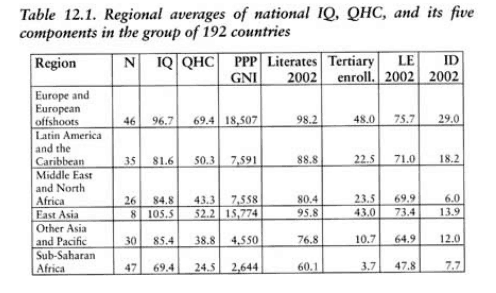
The table above has grouped the 192 countries of this study into regions so as to offer a racial comparison. The headings in the table repeat the five components of the Index of Quality of Human Conditions. N is the number of countries in the group or region, IQ is average IQ for the group, QHC is the Quality of Human Conditions score, PPP GNI is per capita gross national income expressed in dollars, Literates is the percentage of the adult population that can read, Tertiary Enrollment is the percentage of adults who have gone to college, LE is life expectancy, and ID is index of democratization.
The comparisons are instructive. Profs. Lynn and Vanhanen find that the Middle East and North Africa, with an ID of 6.0 is even less democratic than Sub-Saharan Africa with an ID of 7.7. Otherwise, black Africa is at the bottom on all counts. East Asia is clearly not meeting the potential that is suggested by a regional IQ that is almost 10 points higher than that of Europe and its offshoots.
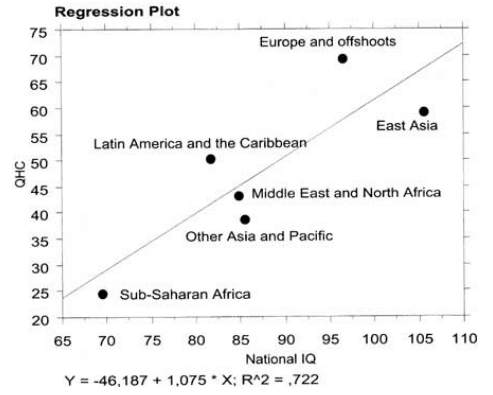
The graph above plots the average IQs of the six regions set out in the previous table against Quality of Human Conditions. The results are not surprising, expect perhaps for the large positive residual for Latin America and the Caribbean, which are probably explained by tourist activity in the Caribbean and close American involvement in Latin America. Although the authors do not say so, the graph also explains the direction of mass immigration. People move out of areas with low QHC scores into white countries with high scores. They would be pouring into Korea and Japan if those countries would let them. If enough lower-IQ immigrants arrive they will, of course, lower the QHC scores of the receiving nations.
One interesting peripheral finding in this book is that IQ correlates better with life expectancy than with any other measure of well-being. High national income simply by itself does not seem to improve life expectancy. For example, oil producing countries may have high incomes but this does not mean their populations live any longer than would be expected based on national IQ.
In this connection, the authors note that in the year 1000, life expectancy at birth is thought to have been essentially the same everywhere in the world: about 24 years. By 1820, the regional variations were as great as they are today, though since the 19th century life expectancy has doubled everywhere.
Profs. Lynn and Vanhanen report a number of interesting parallels, one of which is the very strong correlation of 0.806 between national IQ and what is called the Monaco-Uganda index, or the shape of the population pyramid. Uganda is at one extreme, with a young population and a squat pyramid. Monaco is at the other, with a population “pyramid” that looks like a telephone pole: Each age group survives largely intact into old age, and each generation essentially replaces itself rather than reproduce frantically. The closer a country is to the Monaco model, the higher its national IQ is likely to be.
Another measure of national well-being can be constructed by asking people to rate themselves on various scales of how happy they are. The results, at least at the national level, have no correlation with IQ. The smartest populations are no more likely than the stupidest to say they are happy. There is a modest correlation between happiness and per capita income — extreme misery must make people unhappy — and a weak one with life expectancy.
The authors point out that if neither wealth nor intelligence are necessary for happiness, international development efforts may be misguided. It is hard, probably impossible, to drag most poor countries out of poverty. But if rich countries insist on believing it is their responsibility to help the poor, it may be possible to shore up whatever it is in poor countries that makes people happy.
No one will try this, however, because the people of rich white countries think everyone wants to be just like them: rich, urban, college educated, only moderately religious, sexually “liberated,” and committed consumers who have small families and representative government. An inability to imagine that anything else could be fulfilling is part of the unacknowledged arrogance of the West.
The Heart of the Question
As usual, Richard Lynn and Tatu Vanhanen have gone straight to the heart of a vitally important question. They have shown the folly of trying to implement development policies without regard to the limits set by national IQ. Nations, just like individuals, differ dramatically in their abilities, and in the kind of instruction from which they can profit.
The great obstacle these remarkable authors face is hysterical liberalism that refuses to recognize group differences in IQ. An American society that thinks — or at least pretends to think — that Congress can pass laws that will bring black test scores up to the white level is too deluded to understand why Africa is poor and Japan and Korea are rich. This book should have been published by a major New York house. Instead, it bears the imprint of a plucky but small regional publisher that does not have the muscle to get it widely reviewed or carried in book stores.
This book is mainly about the inability of the West to understand Third-World economies. At a deeper level, it is about the inability of the West even to understand itself.















